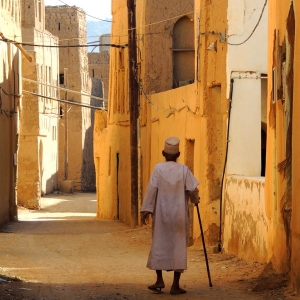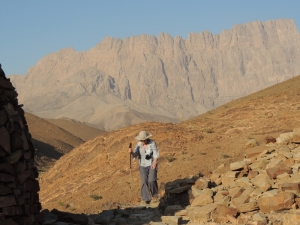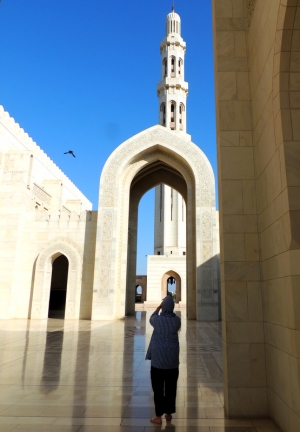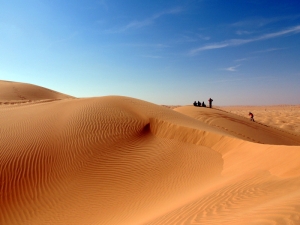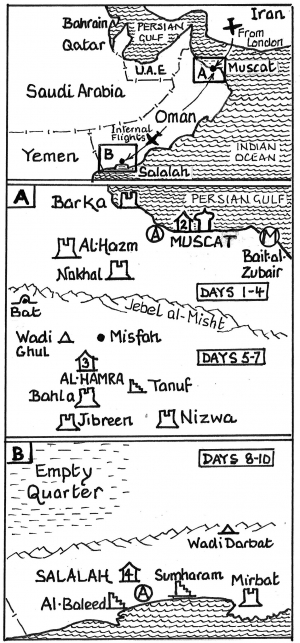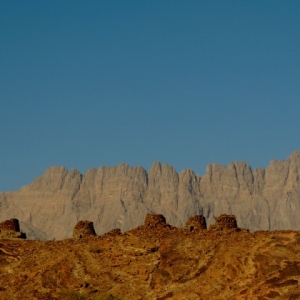
The Oman Experience
The Jewel of the Arabian Peninsula
Classical History and Archaeological ToursExperience ToursGeneral History Tours
4th - 13th January 2027
(10 Days)
Expert Historian : Nick Jackson
Contact us - use the button below to receive more information
The Oman Experience
The Jewel of the Arabian Peninsula
Classical History and Archaeological ToursExperience ToursGeneral History Tours
Your Holiday Essentials
4th - 13th January 2027
(10 Days)
4 star or best available hotels, optional return flights from London, all internal transport including internal flights, meals as indicated in itinerary, all entrance fees, tour manager and expert historian throughout
Expert Historian: Nick Jackson
Incl. travel from UK: N/A
|
|
Tour Introduction
The 15th Century navigator, Ahmad Ibn al-Najdi described the populace of Oman as ‘hospitable and sociable people who love strangers’. His portrayal of Oman’s citizens is as accurate today as it was 500 years ago. While neighbouring oil-rich countries on the Arabian Peninsula are building skyscrapers, shopping malls and huge convention centres, Oman, the oldest independent state in the Arab world, remains firmly attached to its vivid culture and rich heritage. This 11-day tour begins in Muscat, centre for trade on the historic maritime Silk Roads since the 2nd Century AD. From here we travel by 4x4 inland, traversing the Al Hajar mountain range, gateway to Oman’s interior. These isolated mountains and wadis are home to wolves, foxes, jerboas and gazelle. We explore the huge forts of the Jebel Akhdar and the communities built around Oman’s ancient falaj system.
We then fly to the southern city of Salalah, where coconut and banana palms replace the ubiquitous date trees of the north.
Before flying back to Muscat we will be able to dip our toes in the great sand sea, the Rub al Khali, otherwise know as ‘the Empty Quarter’, where there are vast reddish-brown sand dunes up to 250 metres (820 ft) in height.
Background
In recent years, Oman has seldom been in the public eye but the country has played an important part in world history for many centuries occupying as it does a crucial strategic and geographical corner to Arabia and the Indian Ocean. Between the seventeenth and nineteenth centuries, Oman built one of the most notable non-European empires, spanning both the Gulf of Oman and the Indian Ocean. The southern coast was famous in the ancient world as the source of frankincense. The northern coast was one of the most celebrated seafaring areas of the ancient and medieval world. Its contacts with the Middle East, east Africa, the Indian Ocean islands, India and Sri Lanka, even South-East Asia and China, provides a key to an understanding of Asian and African history far beyond its borders.
Highlights
- Take part in a true travel odyssey
- In the company of an expert historian
- Experience vivid culture and rich heritage
- Enjoy the best of Oman’s museums including the newly opened Salut and Oman Through The Ages museums
- Many UNESCO sites visited including Salut and its newly discovered evidence of ancient human settlement
- Explore the sites of the Dhofar War (1963 – 1976) around Salalah
- Experience the Rub al Khali, ‘the Empty Quarter’
What's Included
- 4 Star Hotels
- Meals as indicated in the itinerary
- Modern, comfortable, air-conditioned coach
- Expert historians throughout providing a daily variety of talks, presentations and Q&A
- Welcome drink
- Entrance fees for sites included in itinerary
- Soft drinks with dinner
- Internal flight(s)
- Buffet breakfast each morning
- Return flights from London (optional)
- The company of like-minded travelers
- Tour information booklet
- Dedicated Tour Manager
- Helpful and friendly travel advice
"In the desert I had found a freedom unattainable in civilization; a life unhampered by possessions, since everything that was not a necessity was an encumbrance"
Wilfred Thesiger, Arabian Sands (1959)
Itinerary
Day 1 – Arrival: Fly from London to Muscat. Transfer to Muscat hotel for 2 nights. (D).
Day 2 – Muscat: Full day exploring Muscat: National Museum, Muttrah Souq and the Sultan Qaboos Grand Mosque, the largest mosque in Oman, and one of the country’s most spectacular sites. The main minaret is 90 metres high and the building and courtyards can accommodate 20,000 worshippers. (B, L, D).
Day 3 – Into the interior: Leave Muscat and drive inland to the seventeenth century Nakal Fort, once home of the Yarubid dynasty, and now a museum. From here we travel to the excellent Al Hamrah Bait Safah Museum where we get a fantastic insight into old Omani traditions and ways of life such as juniper-oil production and coffee-bean grinding. Drive on to hotel (TBC) – 1 night. (B, L, D).
Day 4 – Canyons, oases and forts: An amazing day of exploration as we drive into the Wadi An Nakhur, a rocky canyon where we are surrounded by fronded palm trees and dramatic mountain scenery. We return to the oasis of Bahla and its huge fort built by the prosperous Banu Nebhan tribe who dominated the central Omani region from the 12th to the end of the 15th century. Then on to the equally impressive Jabreen Fort built in 1675. We then move to the evocative ruins of Tanuf village and fort. Drive to hotel in Nizwa – 2 nights. (B, L, D).
Day 5 – Nizwa market, Birkat al Mouz and Manah: An early start today to witness the fascinating Nizwa Goat Market, a sale of goats, sheep and cows through open bidding, and one of the most remarkable events in Oman. This lively event gives us a unique insight into the culture and traditions of this intriguing country. We then move to Birkat al Mouz where the ancient falaj system of irrigation is still in operation. Dating from as far back as 500 AD the system tried to divide water equally among all inhabitants. From here we ascend into the cool mountain air of the Jabal al Akhdar to enjoy the spectacular views from Diana’s Point, named after the visit of the Princess of Wales in 1986. Prising ourselves away from this stop we drive down again to Manah where we visit the newly opened Oman Through The Ages Museum and learn about the geological and historical evolution of the Sultanate through a series of superb state-of-the-art exhibitions. This is not to be missed. (B, L, D).
Day 6 – Salut: New discoveries: Today we explore the newly discovered archaeological site at Salut and its Visitor Centre. Here evidence has been found of extensive human settlement dating as far back as the fourth millennium BC and much remains to be discovered at this exciting location, now a UNESCO World Heritage Site. In the afternoon we drive to Muscat airport for our short flight to Salalah. Hotel in Salalah – 2 nights. (B, L, D).
Day 7 – Salalah: A day exploring the Salalah area. Could include Tarqah, Tawi Atair, Wadi Darbat and Sumharam. (B, L, D).
Day 8 – The Frankincense coast and The Empty Quarter: This morning we visit the Al Baleed Archaeological Park and the ruins of Zafar. In the medieval period this was an important port visited by Marc Polo. We will also visit the Museum of Frankincense. After lunch we start our intrepid desert journey driving north in 4x4s to the edge of the Rub' al Khali or Empty Quarter. This enormous sand sea has been a formidable barrier for centuries and the first documented journeys by non-resident explorers were made by British explorers Bertram Thomas and St. John Philby only in the 1930s. We overnight here in a luxury tented camp where we experience the incomparable beauty of the desert and its changing light patterns. (B, L, D).
Day 9 – Return to Muscat: We spend a morning in the desert before driving to Salalah airport to fly to Muscat. Hotel in Muscat – 1 night. (B, L, D).
Day 10 – Departure: Fly Muscat to London. (B)
Recommended Reading List
- A History of Modern Oman
- A Time in Arabia: Living in Yemen's Hadhramant in the 1930s
- Arabian Sands
- Sultan in Oman
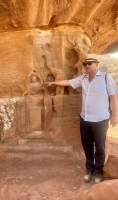
Nick Jackson
Nick Jackson graduated from the Institute of Archaeology, University College London, then worked for over a decade as a field director, excavating the ancient history of the Eastern Mediterranean.
After a research post at the University of Cambridge, he has spent over 25 years as a guide lecturer in Syria, Jordan, Lebanon, Israel and Oman.
Ongoing research has recently produced a synthesis of Oman’s story, placing it surprisingly at the centre of a more familiar narrative of Mesopotamian history. A very young nation in the contemporary world, exciting echoes of its unique past can still be heard in Oman today.
In 1993, after a project in Bolivia for the University of Berkeley, California, Nick moved to Berlin to work at the Academy of Art, and has guided on German and central european military history, has been a guest lecturer on Holocaust Studies at Stanford in Berlin, consulted for and presented TV documentaries and is a book researcher and sometime journalist.
Your Holiday Essentials
4th - 13th January 2027
(10 Days)
4 star or best available hotels, optional return flights from London, all internal transport including internal flights, meals as indicated in itinerary, all entrance fees, tour manager and expert historian throughout
Expert Historian: Nick Jackson
Incl. travel from UK: N/A
|
|

